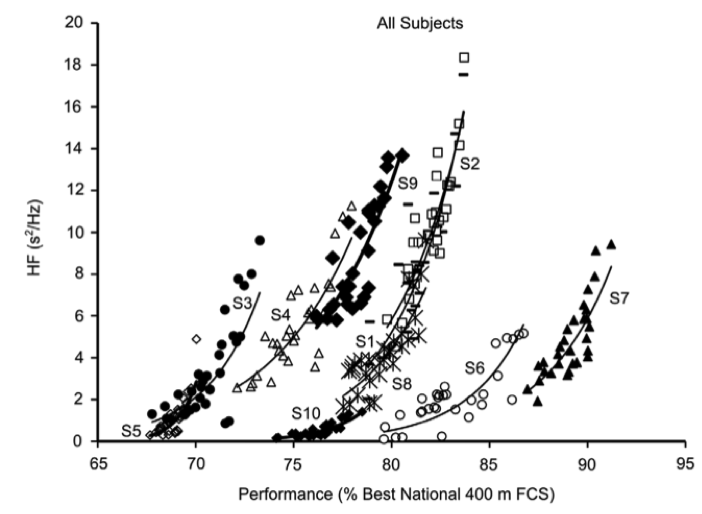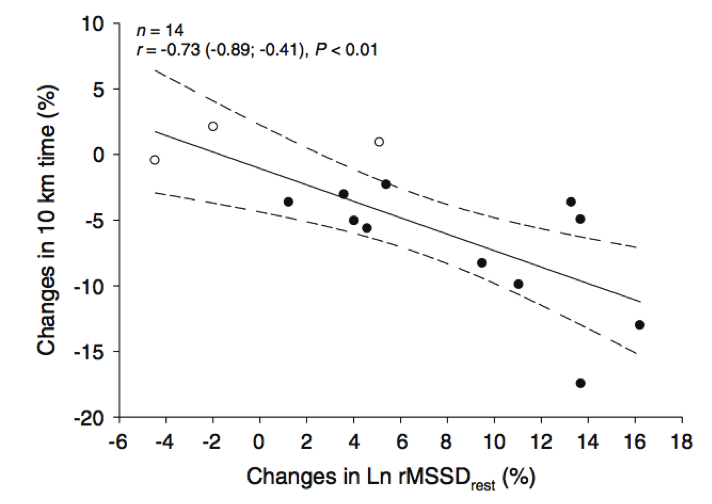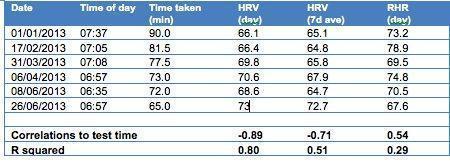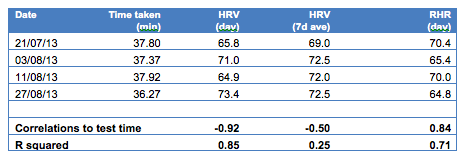Who, what, why?
In two previous posts, we summarised studies that showed an almost unbelievable ability for night-time / morning heart rate variability (HRV) to predict the changes in performance of both swimmers and club runners.
HRV and Swimming Time Trial Results
The results from this study by Chalencon et al. were astounding to me. In the case of the swimmers, the researchers found that their performance in a weekly 400m time trial test could be predicted with very high accuracy. The correlation, or r2 value was 0.84 indicating that 84% of the variation in the swimmers performance could be predicted from their daily HRV readings, as shown in this chart:

In fact the relation they found was so strong that they concluded using performance or HRV as the systems (model) output provided the same information on the impact of training on the fatigue and adaptation status of the athlete.
HRV predicting running performance
In the other study, a team of researchers led by Dr Martin Buchheit set out to assess relationships between running performance and HRV. The assessment was conducted during an 8 week training program in club level (not elite) runners who had performed at least one 10k race in the previous year. Participants performed a 10k run before a coach supervised training program and then again at the end, after a short tapering period designed to maximise performance.
Participants with the highest starting HRV were the fastest runners, but those with lowest starting HRV showed the most improvement.
What again was amazing to me was that all those who responded to the training showed increases in their morning HRV, and the ones with the largest increases in HRV showed the largest gains in performance.
The chart below shows that an improvement of 10% in 10k run time required an average of 15% improvement in morning HRV (LnRMSSD, the measure used in ithlete).
HRV and Cycling Performance?
As a keen recreational cyclist, I was interested to see whether these findings could be replicated using ithlete daily waking measures in a small pilot study.
What did we do?
Two male, moderately trained masters recreational road cyclists who had been using the ithlete app on a daily basis performed regular time trials as part of their training. They measured HRV (LnRMSSD) at morning wake every day using the ithlete app following the paced breathing pattern for 55 seconds in a standing position. Although a consumer app, the ithlete system has been validated for accuracy against medical ECG (Flatt, 2013).
- Cyclist 1 rode a fixed 25km loop time whilst aiming to maintain a constant HR of approximately 1st ventilatory threshold (135-140 bpm). The exercise was repeated 6 times over a period of 6 months.
- Cyclist 2 rode a maximum sustained effort (individual time trial) over the precise length of an Alpine climb (Col de Vence), 4 times over a period of 6 weeks during the summer.
The aim was to see how much of the variation in performance would be explained by HRV (as a daily measure as well as using the 7 day rolling average baseline). We also wanted to see how well the resting heart rate recorded at the same time as the HRV would predict the variation in performance.
What did we find?
For the first cyclist, who was aiming to maximize their speed for a given heart rate, the table below shows very good correlation with waking HRV and good correlation with the 7 day HRV average, but only a moderate correlation with resting heart rate (RHR).
For the second cyclist, aiming to ride up the Col de Vence as fast as possible at maximum effort, the correlation to morning wake HRV was very good, but the relation to 7 day rolling average HRV was much weaker. Correlation to resting HR was also very good.
What does it mean?
I was nervous when I started analysing the data for this study because I feared we would not find anywhere near such robust correlations as the previous studies, and the bubble would be burst. But this was not the case at all, and the correlations in this limited size study were just as good as those found in the previous well conducted studies on the swimmers and runners.
Maximum aerobic capacity can be predicted from resting heart rate (VO2max = HRmax/RHR x 15.2), so we were expecting lower values of resting heart rate (RHR) to predict better performance, but the evidence so far is that the isolated parasympathetic HRV component is a better predictor.
We also did not expect the daily HRV measure to be a better predictor than the smoothed 7 day average. One explanation we can think of is the use of paced breathing in the present study. Whilst Al Haddad et al have reported typical coefficient of variation (CV) of 12% for individual ultra short measures of LnRMSSD, the daily test reliability of some ithlete users is closer to CV = 5%.
In conclusion, these results may indicate that the strong relationship between HRV and variation in individual athletic performance in previous published studies may be measured over 60 seconds. It does require replication in a larger sample and in different sports, since it could be that these findings don’t apply to power / strength / explosive sports where other energy systems and factors may dominate.
Nonetheless, knowing that your performance in aerobic and endurance sports is related to changes in your HRV provides further reasons, beyond assessing recovery and readiness to train to track HRV and to find ways of maximizing it before important events such as key races.




In the studies cited, were the athletes aware of their morning HRV score? If not, there could certainly be placebo effect. Thanks!
Hi Terrence. I don’t believe the athletes in the swimming & running studies were aware of their morning HRV scores, but the cyclists were in the small scale pilot. It’s a valid point and in larger studies, researchers should pay attention to this – ie conduct the HRV tests blind (perhaps even double blind if they have daily contact with the subjects).